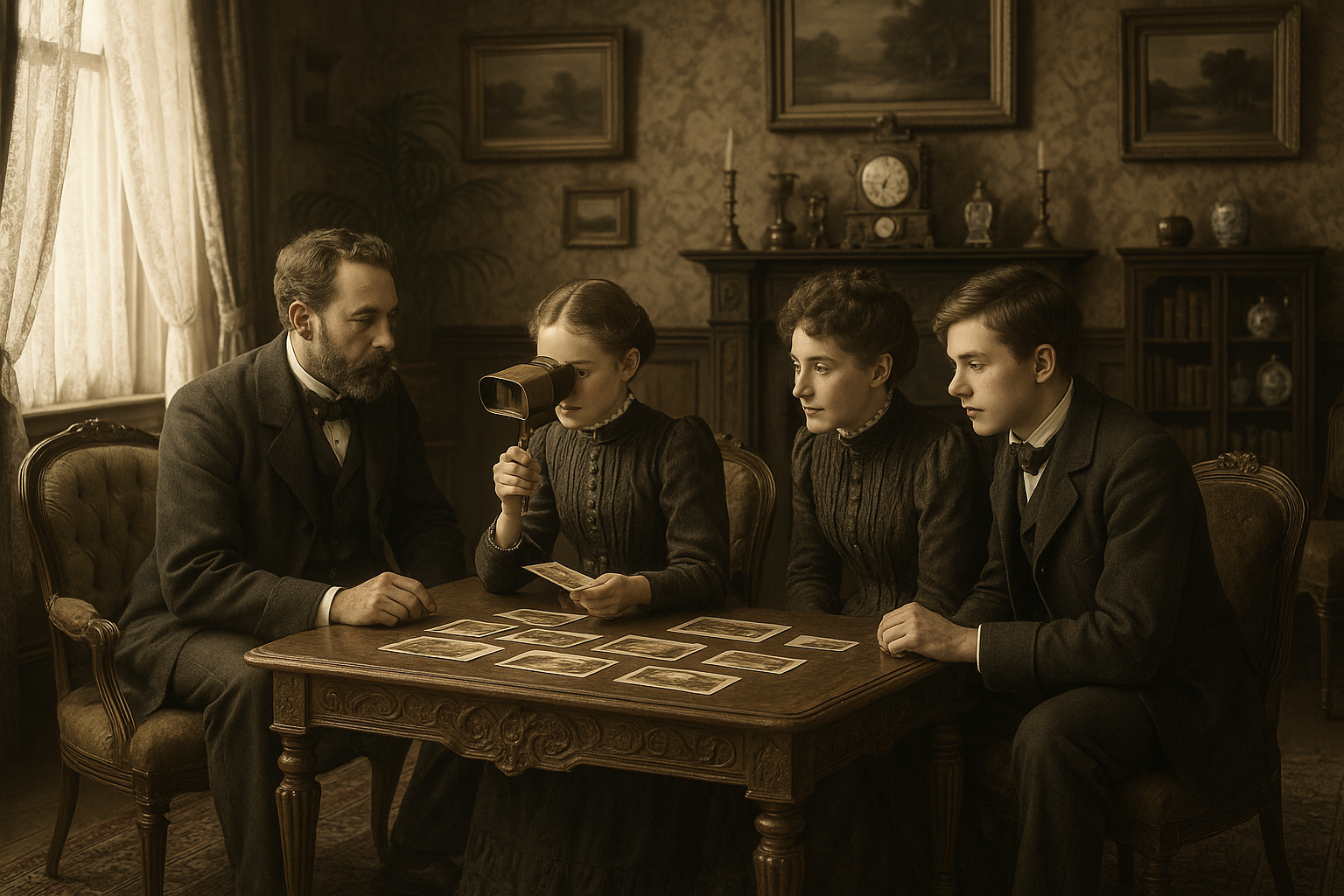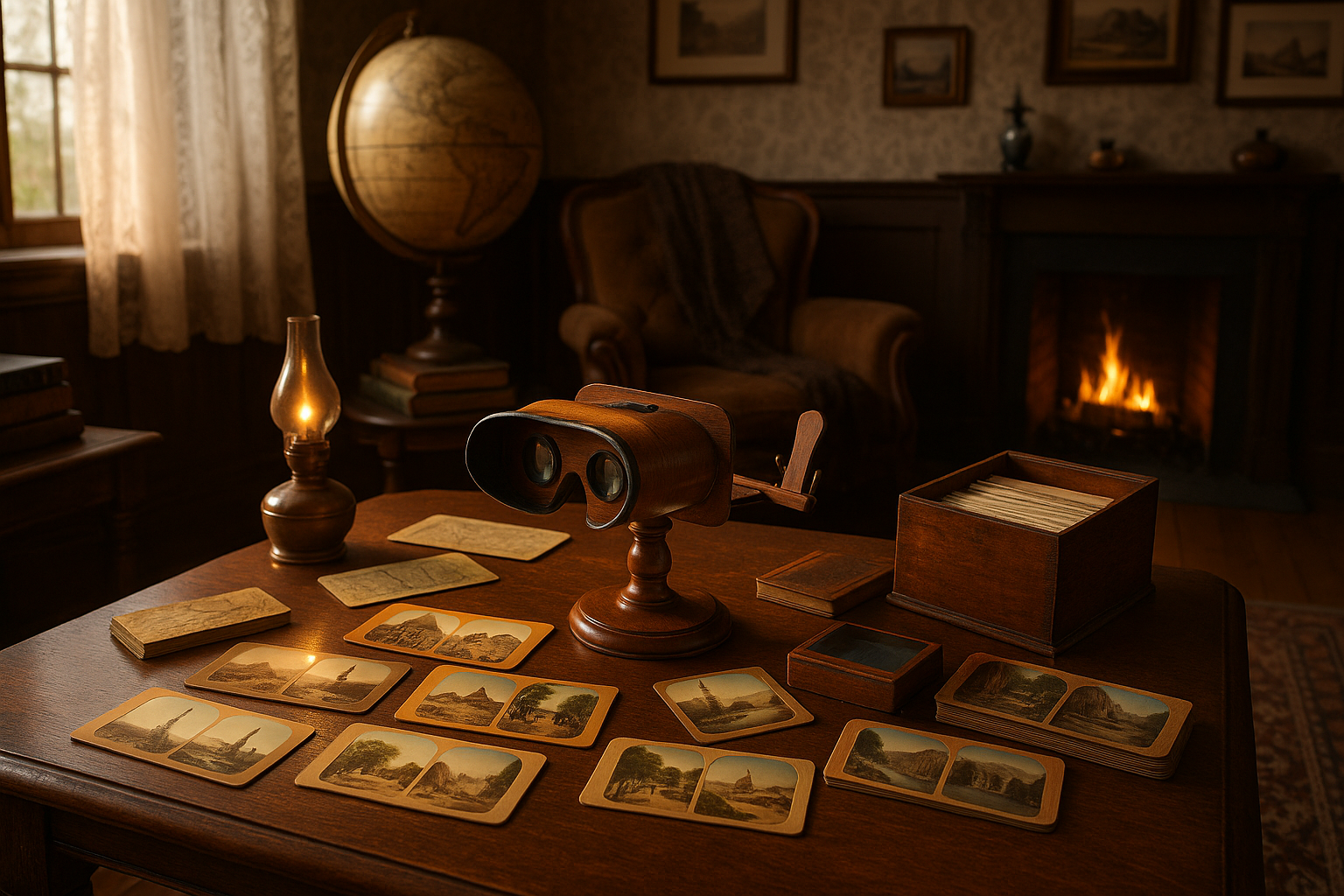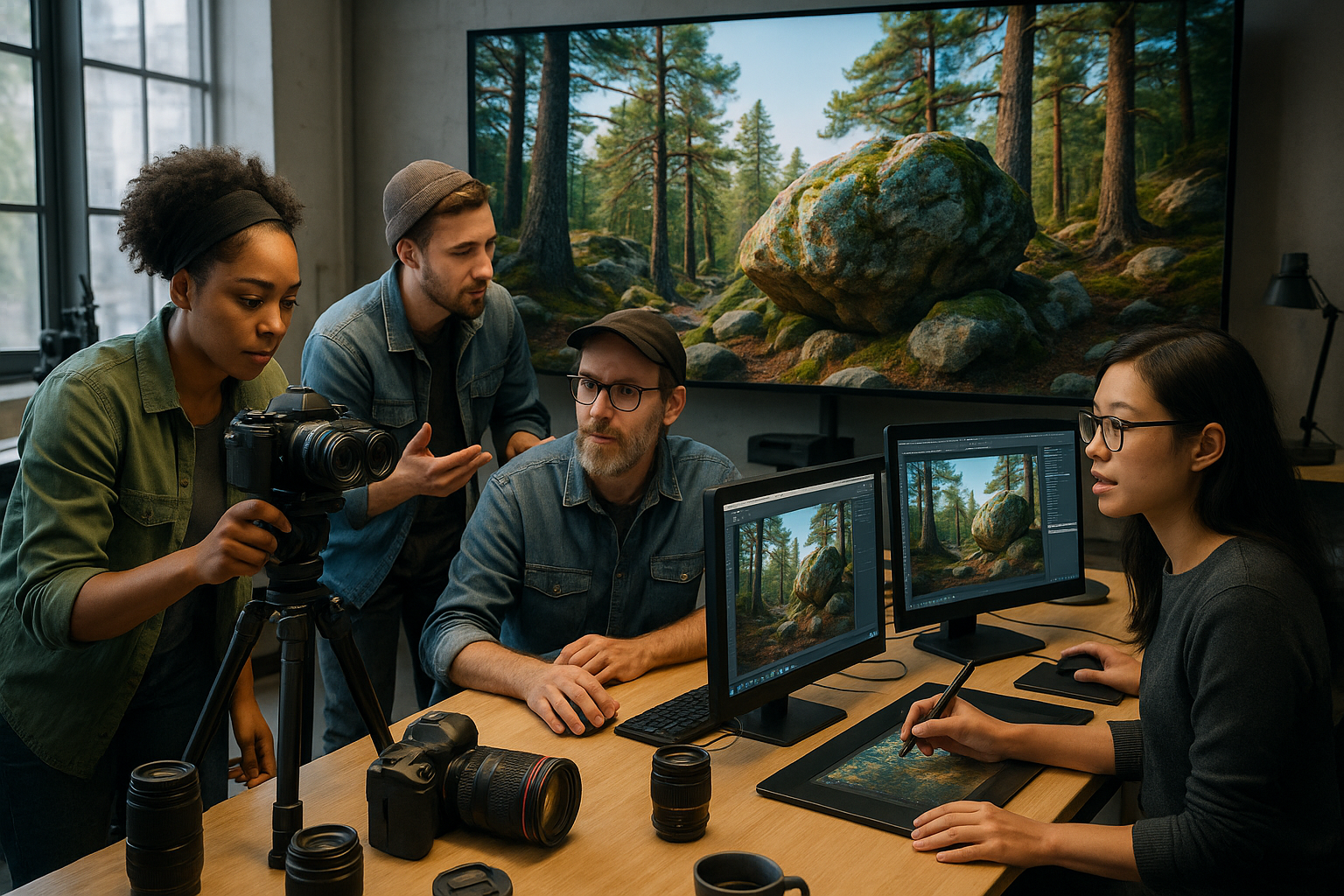In a world where technology constantly pushes the boundaries of what we once deemed possible, the pursuit of richer, more immersive visual experiences is a never-ending journey. Imagine stepping into your living room, dimming the lights, and being transported into a realm where images pop with an uncanny realism, as if you could reach out and touch them. This isn’t the stuff of science fiction or high-budget movie sets, but rather the mesmerizing magic of stereoscopes — an age-old technology making a triumphant return to redefine how we experience visuals at home. 📽️✨
Stereoscopes, with their intriguing ability to render depth and dimension, first captivated audiences in the 19th century, when they were revolutionary in offering glimpses of far-off lands and iconic moments in a way that felt tantalizingly real. Today, they are experiencing a resurgence, captivating a new generation hungry for unique and engaging visual experiences. But what exactly is a stereoscope, and why is it staging such a spectacular comeback in our digitally dominated age? In essence, a stereoscope takes two slightly different images and presents them in a manner that our brains naturally interpret as three-dimensional. This simple yet effective trick of perception transforms flat images into immersive scenes, igniting our imaginations and enhancing our viewing pleasure.
In this article, we’ll explore the fascinating journey of stereoscopes, from their historical origins to their modern-day applications. We’ll delve into how this technology has evolved and adapted to contemporary tastes, and why it holds such a powerful allure in today’s world. Whether you’re a technology enthusiast, a lover of visual arts, or simply someone seeking to enhance your home entertainment system, the stereoscope offers an experience that is both nostalgic and futuristic, bridging the gap between past and present. We’ll discuss how incorporating stereoscopes into your home can elevate everything from family photo viewing sessions to movie nights, offering a unique blend of education, entertainment, and aesthetic appeal.
Moreover, we’ll offer practical tips on how to choose the right stereoscope for your needs, as well as creative ways to integrate this technology into your everyday life. From understanding the science behind 3D vision to exploring the latest innovations in stereoscopic technology, this article will provide you with a comprehensive guide to transforming your home viewing experience. Get ready to rediscover the world of 3D, where every image tells a story and every scene invites you to explore it from a whole new perspective. So, sit back, relax, and prepare to embark on a journey through the enchanting world of stereoscopes — where the magic of 3D awaits you just beyond the lens. 🎥🔍
The Evolution of 3D Viewing: From Classic Stereoscopes to Modern Home Experiences
Since the dawn of visual entertainment, humans have been fascinated by the concept of three-dimensional (3D) imagery. The journey of 3D viewing began with the humble stereoscope, a device invented in the 19th century, allowing people to view images in a way that simulated depth perception. These early devices laid the foundation for the technological advancements we enjoy today in home entertainment systems. Understanding the history and evolution of 3D technology helps appreciate the immersive experiences available in modern times.
The original stereoscope worked by displaying two slightly different images, one for each eye, creating an illusion of depth. This simple yet ingenious design captivated audiences, transforming how they perceived images. Over time, this fascination with 3D grew, and technology evolved, leading to the development of anaglyph glasses, polarized glasses, and eventually, digital 3D systems that enhance home viewing experiences today. These advancements have allowed for more comfortable and vivid experiences, paving the way for innovations in both hardware and content creation.
Modern 3D technology has become an integral part of home entertainment systems, with many televisions, projectors, and gaming consoles offering 3D capabilities. This transition from the basic stereoscope to advanced home setups has been driven by a desire for more immersive and engaging viewing experiences. By understanding the roots of this technology, we can better appreciate the magical transformation it has undergone and how it can enrich our home viewing experiences today.
Understanding Stereoscopes: The Gateway to 3D
Stereoscopes were invented in the 1830s by Sir Charles Wheatstone, who discovered that each eye perceives an image from a slightly different angle, creating a sense of depth when combined. This principle led to the creation of stereoscopic devices that utilized two images taken from slightly different perspectives. The viewer would look through a pair of lenses that merged the images into one, creating a 3D effect. This simple yet effective method opened the door to a new dimension of visual storytelling.
The stereoscope quickly gained popularity in the 19th and early 20th centuries as a form of entertainment and education. People used stereoscopes to view landscapes, architecture, and even exotic places they could never visit. This technology provided a unique way to explore the world, capturing imaginations and inspiring future innovations in visual media. Despite its rudimentary nature, the stereoscope was a revolutionary tool that forever changed the way people experienced visual content.
As technology advanced, the stereoscope was eventually overshadowed by more sophisticated 3D viewing methods. However, it remains an important part of history, serving as a testament to human curiosity and innovation. The principles of stereoscopic viewing continue to underpin modern 3D technology, reminding us of the simple beginnings of our journey into the world of 3D imagery.
Modern 3D Home Entertainment Systems: A Technological Leap
In today’s world, the fascination with 3D technology has transcended beyond simple entertainment. Modern home entertainment systems incorporate advanced 3D technologies that provide a more immersive and realistic viewing experience. From 3D televisions and projectors to VR headsets and gaming consoles, these systems have made it possible to enjoy three-dimensional content in the comfort of our own homes. The evolution from stereoscopes to modern 3D systems is a testament to how far we’ve come in creating immersive visual experiences.
The modern 3D experience is powered by several technologies that enhance image quality and viewer comfort. Technologies like active shutter glasses and passive polarized glasses have replaced the traditional anaglyph glasses, offering more vibrant colors and better depth perception. These advancements have allowed viewers to enjoy movies, sports, and video games with a level of immersion that was once thought impossible. Moreover, the rise of 3D content production has further fueled the demand for 3D-capable devices, ensuring a wide array of options for consumers seeking an enhanced viewing experience.
Beyond just entertainment, 3D technology has found applications in various fields such as education, medicine, and engineering. In education, 3D models and simulations provide students with a more interactive learning experience. In medicine, 3D imaging aids in diagnostics and surgical planning, while in engineering, it helps visualize complex structures and designs. The versatility of 3D technology demonstrates its potential to transform not just how we entertain ourselves, but also how we learn and work.
The Benefits and Challenges of Home 3D Viewing
Embracing 3D technology in home entertainment brings numerous benefits, offering an engaging and interactive experience that captivates audiences. The sense of depth and realism enhances storytelling, making movies and games more compelling. This immersive quality is not just limited to entertainment; educational content and documentaries become more impactful when presented in 3D, allowing viewers to explore and understand complex subjects in a more intuitive manner.
Despite its benefits, 3D technology in home entertainment does come with challenges. Some viewers experience discomfort or eye strain when watching 3D content for extended periods. Additionally, the cost of 3D-capable devices and the need for specialized glasses can be a barrier for some consumers. Furthermore, the availability of quality 3D content remains limited compared to traditional 2D offerings, although this is gradually improving as more creators embrace the potential of 3D storytelling.
As the technology continues to evolve, it is likely that these challenges will be addressed, making 3D home viewing more accessible and enjoyable for everyone. The ongoing development of glasses-free 3D displays and improvements in image processing are promising steps towards a more comfortable and user-friendly experience. These innovations will ensure that the magic of 3D continues to captivate audiences for generations to come.
How to Enhance Your Home 3D Viewing Experience
To make the most of your home 3D viewing experience, it’s important to set up your equipment correctly and choose the right content. Start by selecting a high-quality 3D TV or projector that suits your space and viewing preferences. Ensure that your viewing environment is optimized for 3D, with proper lighting and seating arrangements that allow for the best depth perception. Regular maintenance of your equipment, such as cleaning lenses and updating firmware, can also enhance your experience.
When selecting content, look for movies, games, and shows specifically designed for 3D viewing. Many streaming services and Blu-ray discs offer a variety of 3D options, allowing you to explore a wide range of genres and styles. Consider creating a dedicated 3D viewing space in your home, complete with comfortable seating and high-quality sound systems, to maximize the immersive experience. Sharing this space with family and friends can make 3D viewing a social event, further enhancing the enjoyment.
Finally, don’t hesitate to explore new technologies and innovations in 3D viewing. Virtual reality (VR) headsets, for example, offer a unique and highly immersive 3D experience that transports users to different worlds. As the technology becomes more affordable and widespread, incorporating VR into your home entertainment setup could revolutionize how you experience 3D content. Embrace the magic of 3D technology and transform your home viewing experience into something truly extraordinary.
| Feature | Stereoscope | Modern 3D Systems |
|---|---|---|
| Technology | Analog, dual-image | Digital, active/passive glasses |
| Image Quality | Limited resolution | High definition, vibrant colors |
| Comfort | Basic viewer | Advanced ergonomics |
Discover more about the evolution of 3D technology by watching this informative video:
Understanding 3D Technology – The Science Channel
- Choose a high-quality 3D TV or projector for the best experience.
- Create a dedicated 3D viewing space with optimal lighting and sound.
- Explore a variety of 3D content, from movies to virtual reality.

Conclusion
In conclusion, the exploration of stereoscopes and their transformative potential for home viewing experiences takes us on a fascinating journey through the intersection of history, technology, and sensory engagement. Throughout this article, we delved into the evolution of stereoscopic technology, tracing its origins back to the 19th century and examining its resurgence in modern-day applications. We highlighted how stereoscopes can revitalize the way we consume visual content, offering a more immersive and lifelike experience compared to traditional 2D viewing.
One of the primary points discussed was the historical significance of stereoscopes, which first captured the public’s imagination in the Victorian era. Back then, they offered a novel way to experience far-off places and events, creating a sense of presence that was previously unattainable. Today, as we embrace the digital age, stereoscopes have undergone a renaissance, incorporating cutting-edge technologies that enhance their capabilities and broaden their appeal.
We also explored the technical advancements that have enabled modern stereoscopes to deliver high-quality, three-dimensional images. Innovations such as improved lenses, digital displays, and virtual reality integration have allowed for greater clarity and depth perception. These advancements have made stereoscopes more accessible and user-friendly, encouraging a wider audience to experience the magic of 3D in their own homes.
The benefits of stereoscopic viewing extend beyond mere entertainment. Educational applications, such as virtual field trips and interactive learning modules, demonstrate how stereoscopes can be powerful tools for knowledge acquisition and cognitive development. By providing a more engaging and interactive experience, stereoscopes can enhance learning outcomes and stimulate curiosity in learners of all ages.
Furthermore, the article highlighted the potential for stereoscopes to revolutionize various industries, including gaming, filmmaking, and interior design. In gaming, the added dimension of depth can create more immersive and realistic environments, elevating the overall experience for players. In filmmaking, directors can craft more dynamic and visually compelling narratives, drawing audiences deeper into the story. Meanwhile, in interior design, stereoscopes can offer clients a virtual walkthrough of their future spaces, enabling them to make informed decisions about layout and aesthetics.
As we consider the implications of these advancements, it’s important to recognize the ongoing challenges and opportunities in the field of stereoscopic technology. Issues such as cost, accessibility, and content availability must be addressed to ensure that the benefits of stereoscopes are widely realized. However, the continued investment in research and development, along with collaborations between technology companies and content creators, holds promise for overcoming these hurdles.
In emphasizing the importance of this topic, we must acknowledge the broader cultural and societal impact of stereoscopic technology. By fostering a deeper connection to visual content, stereoscopes have the potential to enrich our lives and expand our perspectives. They remind us of the power of innovation to transform everyday experiences and inspire wonder in the world around us.
We invite you, our readers, to reflect on how stereoscopes can enhance your own viewing experiences. Whether you are an avid film enthusiast, a curious learner, or someone seeking new ways to engage with visual content, we encourage you to explore the possibilities that stereoscopes offer. Share your thoughts and experiences in the comments section below, and consider sharing this article with friends and family who might also be intrigued by the magic of 3D.
By staying informed and embracing new technologies, we can continue to push the boundaries of what is possible and create richer, more meaningful connections with the world. So, go ahead and dive into the world of stereoscopes—experience the magic for yourself and discover how it can transform your home viewing experience! 🌟
For further reading and to keep up with the latest developments in stereoscopic technology, check out these active sources:
1. Stereoscopy News – A comprehensive resource for news and updates on stereoscopic technology.
2. 3D Vision Blog – A blog dedicated to 3D technology, including stereoscopic advancements.
3. Stereoscopic Society – A society that promotes the art and science of stereoscopy.
We hope you find these resources valuable as you continue to explore the captivating world of 3D viewing!
Toni Santos is a visual historian and artisan whose creative lens is captivated by the forgotten marvels of antique optical devices. Through his thoughtful storytelling, Toni revives the instruments that once transformed light into wonder—camera obscuras, magic lanterns, kaleidoscopes, and other ingenious tools that shaped our earliest visual imaginations.
His journey is rooted in a fascination with how humans have long sought to bend, reflect, and reveal the unseen. Whether tracing the mechanical poetry of 19th-century projectors or illustrating the tactile elegance of early lenses, Toni’s work invites us to see vision itself as an evolving art form.
Blending handcrafted design with historical inquiry, Toni brings to life the material soul of these devices—celebrating not just how they functioned, but what they meant. His creations and curated stories illuminate a world where science, illusion, and beauty were intricately linked through glass and brass.
As the curator of Vizovex, Toni shares detailed studies, reconstructed artifacts, and immersive content that help others rediscover the origins of visual technology and the magic of analog perception.
His work is a tribute to:
The craftsmanship behind early visual instruments
The wonder of seeing through the eyes of another century
The intersection of optics, art, and imagination
Whether you’re a collector, a designer, or someone drawn to the lost poetry of vision, Toni welcomes you into a world where light is a storyteller—one prism, one lens, one forgotten invention at a time.





